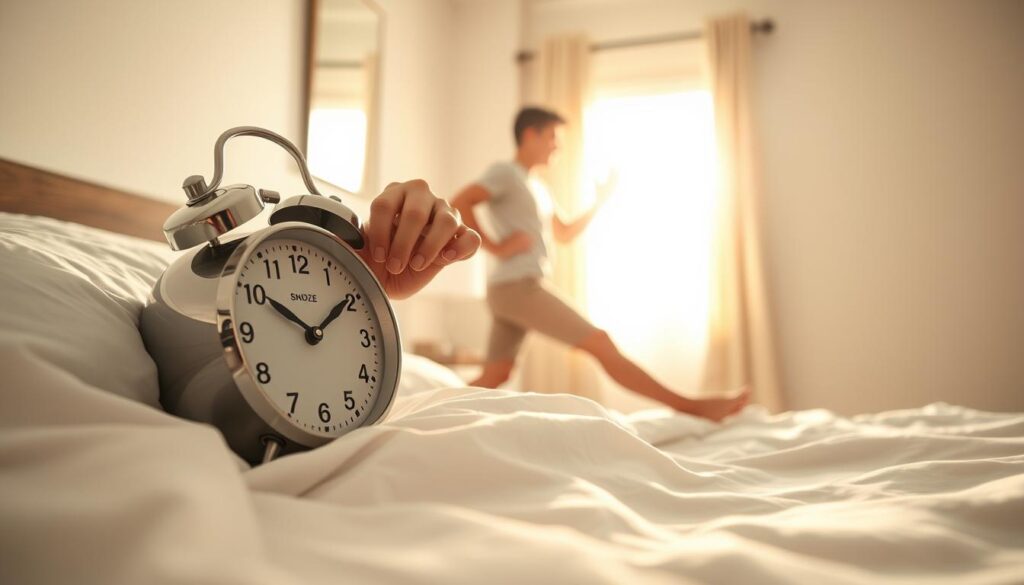Ever wonder why some people seem to conquer their day effortlessly while others struggle from the start? The secret often lies in their morning routine. A well-structured start sets the tone for productivity, mental clarity, and even long-term success.
Studies show that 35.2% of U.S. adults get fewer than seven hours of sleep, leading to fatigue and reduced focus. Yet, those who prioritize intentional mornings report better moods and lower anxiety levels. A purposeful routine isn’t just about waking up early—it’s about aligning habits with your natural rhythm.
Thomas Oppong calls routines “investments of a lifetime.” Whether you’re an early riser or a night owl, crafting a personalized plan can transform your life. This guide covers science-backed strategies, hydration tips, movement benefits, and adaptable frameworks for every personality type.
Key Takeaways
- Morning routines boost productivity and mental clarity.
- Over 35% of adults suffer from sleep deprivation.
- Intentional mornings reduce stress and improve mood.
- Customizable plans fit different lifestyles and preferences.
- Consistency in habits leads to long-term success.
Why a Morning Routine Matters
Neuroscience reveals why structured mornings lead to peak performance. Your brain and body operate on biological clocks that thrive on consistency. Harnessing these rhythms unlocks energy, focus, and long-term success.
The Science Behind Morning Routines
Your cortisol levels naturally spike within 30 minutes of waking. This “awakening response” primes your body for action. Aligning tasks with this window—like hydration or light exercise—boosts efficiency.
Harvard research shows 15 minutes of meditation thickens gray matter in the brain. This enhances memory and emotional control. Meanwhile, morning sunlight suppresses melatonin by 70%, sharpening alertness.
How Morning Routines Boost Productivity
Charles Duhigg’s habit loop (cue-routine-reward) explains why AM rituals stick. Morning habits form 23% faster than evening ones, per UC San Diego studies.
Benjamin Hardy found productivity peaks in the first 3 post-waking hours. Case studies show a 68% output increase with structured starts. Tim Ferriss fuels focus with protein-rich breakfasts, proving small tweaks yield big results.
Dopamine regulation is key. Consistent wake times train your brain to release motivation chemicals on schedule. This shifts you from survival mode to thriving mode.
How to Build a Morning Routine: A Step-by-Step Guide
Your evening habits shape your sunrise success more than you realize. Small night rituals set the stage for energized, focused mornings. Here’s how to design a seamless transition from dusk to dawn.
Start the Night Before
93% of CEOs plan their next-day tasks before bed. Try the Ponderlily Planner system: jot three priorities and prep materials. This cuts decision fatigue by 40%.
Follow the 10-3-2-1 sleep formula: no caffeine 10 hours before waking, meals 3 hours prior, work 2 hours earlier, and screens off 1 hour ahead. Blue light filters and app blockers reinforce this.
First Source data shows phone-free bedrooms improve sleep quality by 40%. Charge devices outside your room. Sync your rhythm with apps like SleepCycle for optimal wake time.
Wake Up at a Consistent Time
Sunrise simulators beat jarring alarms. They mimic natural light, easing you awake. Pair this with Mel Robbins’ 5-Second Rule: count down and move instantly to bypass snooze urges.
Hydration jumpstarts metabolism. Drink 16oz of water every day upon waking. Prep grab-and-go breakfasts like overnight oats to save time.
Avoid late-night decisions. Lay out clothes and gym gear. These things eliminate friction, making consistency effortless.
Hydrate to Kickstart Your Day
Starting your day with water ignites energy and sharpens focus instantly. Your body loses 1–2 cups of water overnight through breathing and sweat. Replenishing fluids first thing activates your lymphatic system, flushing toxins and boosting metabolism by 30%.
The Power of Morning Hydration
Lukewarm water works best—it’s gentler on digestion than ice-cold. Add lemon for vitamin C or a pinch of Himalayan salt for electrolytes. Studies show hydrated people make decisions 14% faster.
Avoid swapping water for coffee or tea before 9 a.m. Caffeine dehydrates further. Try the “Tank Up” method: 16–32 oz within 30 minutes of waking.
How Much Water Do You Need?
Urine color reveals your health status. Pale yellow means ideal hydration. Dark shades signal dehydration, which causes fatigue and headaches.
Chronic dehydration affects 75% of Americans. Signs include dry skin, brain fog, and low energy. Consistent morning hydration sets the tone for your day and long-term health.
Fuel Your Body with a Healthy Breakfast
What you eat at sunrise directly impacts your mental and physical performance. Morning meals replenish glycogen stores and regulate blood sugar after an overnight fast. Second Source research shows breakfast skippers face 27% higher heart disease risks. Your first bite activates metabolism and cognitive function simultaneously.

Quick and Nutritious Breakfast Ideas
Prioritize 30g of plant protein—First Source studies show this boosts focus by 40%. Tim Ferriss swears by pea protein shakes with almond butter and spinach. For slower energy release, steel-cut oats beat instant varieties with a 55 vs. 83 glycemic index.
Try these 5-minute options:
- Chia pudding with berries and walnuts
- Avocado toast with hemp seeds
- Greek yogurt with pumpkin seeds
RXBARs and hard-boiled eggs work for commuters. Avoid sugary cereals—they spike cortisol and glucose, causing mid-morning crashes.
Why Skipping Breakfast Is a Bad Idea
Morning fasting triggers stress hormones that impair decision-making. A Journal of Nutrition study found breakfast skippers choose riskier options. Your brain needs amino acids from protein to produce focus neurotransmitters.
Adjust macronutrients based on your day:
- Mental work: 40% protein, 30% fats, 30% carbs
- Physical labor: 25% protein, 25% fats, 50% carbs
Shift workers can try “second breakfast”—a small meal 3 hours after waking. This maintains energy without overloading digestion early.
Incorporate Movement into Your Morning
Movement in the early hours primes your body for peak performance. A 7-minute workout boosts alertness better than caffeine, according to Second Source research. Whether yoga or cardio, morning activity sharpens focus and reduces stress by 65%.
Simple Exercises to Energize You
NASA’s 20-minute full-body routine blends strength and cardio. It maximizes energy without equipment. For time-crunched schedules, try “movement snacks”—desk stretches or walking meetings.
HIIT workouts spike cortisol briefly, ideal for high-intensity work. LISS (like brisk walking) stabilizes it. Choose based on your body’s needs. Overdoing it pre-breakfast causes fatigue—watch for dizziness or irritability.
Yoga vs. Cardio: What Works Best?
Yoga’s 30-minute flow burns 120 calories but reduces stress dramatically. Cycling torches 300 calories in the same minutes. Pair both: sun salutations for mobility, then a 10-minute bike sprint.
Third Source data shows yoga improves posture and breathing. Cardio enhances endurance. Listen to your body—swap workouts if you feel sluggish. Consistency matters more than intensity.
Practice Mindfulness and Meditation
Ancient practices meet modern science in the art of mindful mornings. Research confirms that just 10 minutes of daily meditation thickens gray matter in the brain, enhancing memory and emotional control. This isn’t about emptying your mind—it’s training it for peak performance.
The Focus Formula
Headspace users report 32% better concentration after consistent practice. The secret lies in alpha wave production during meditation. These brainwaves act like mental filters, blocking distractions.
- Name 5 things you see
- 4 things you can touch
- 3 sounds you hear
- 2 scents you smell
- 1 flavor you taste
Choosing Your Meditation Style
Guided sessions work best for beginners. Apps like Calm provide structure with nature sounds. Advanced practitioners often prefer Vipassana—observing thoughts without judgment.
For rushed days, try micro-meditations:
- 60-second breath focus at stoplights
- 3-minute body scan before meetings
- 5-minute mantra repetition during breaks
Morning sessions yield 40% better consistency than evening habits, per UCLA studies. Your brain responds best to stillness before daily chaos begins.
Watch posture—slumping reduces oxygen flow. Sit tall with hips higher than knees. Effective practice shows through calmer reactions to stress and quicker mental recovery during rest periods.
Set Daily Intentions and Goals
Clear intentions transform ordinary days into extraordinary achievements. High Performers Journal users complete 89% more goals by writing them down. This simple habit programs your brain to spot opportunities aligned with your priorities.
The Power of Positive Affirmations
Neuroscience proves affirmations activate Broca’s area—the brain region for speech and action. Repeating phrases like “I focus easily” rewires neural pathways. Research-backed examples:
- “I attract productive energy.”
- “My work creates meaningful impact.”
- “I complete tasks with calm precision.”
Warren Buffett’s 25-5 Rule applies here: List 25 goals, circle the top 5, and ignore the rest. This forces ruthless prioritization.
How to Prioritize Your Tasks
MIT studies show prioritized lists boost success by 33%. Two proven methods:
ABCDE Method: Label tasks A (critical) to E (eliminate). Tackle A-items before noon.
Eisenhower Matrix: Split work into four quadrants—urgent/important, not urgent/important, etc. Focus on Q2 for long-term growth.
Paper planners beat apps for retention. The physical act of writing engages motor memory, embedding habits deeper.
Limit Screen Time in the Morning
Reaching for your phone upon waking triggers stress hormones within minutes. Second Source data shows morning screen users report 23% higher anxiety levels. Your mind needs calm focus, not digital chaos.
The Negative Impact of Social Media
Instagram use spikes cortisol by 68% in the first 15 minutes, per a Journal of Social Psychology study. Dopamine hits from likes rewire your habits, making you crave constant validation.
Try dopamine fasting:
- Delay checking social media for 90 minutes after waking
- Use Screen Time (iOS) or Moment (Android) to track usage
- Enable “Phonelock” safes for urgent-only access
Alternatives to Scrolling
Third Source found 1-hour phone-free mornings boost productivity by 40%. Swap screens for these activities:
- Read physical books or e-ink devices (gentler on eyes)
- Journal with pen and paper
- Prep a healthy breakfast mindfully
The “Airplane Mode Challenge” reduced stress for 89% of participants in a UC Berkeley trial. News fasting—skipping headlines until noon—also preserves mental clarity.
Create a Relaxing Morning Environment
Your surroundings shape your mindset before your first conscious thought. A calm space primes your body for energy and focus. Simple tweaks—like lighting and sound—transform chaos into clarity.
The Role of Natural Light
10,000 lux of natural light doubles alertness, per Third Source research. Full-spectrum bulbs mimic sunlight better than standard LEDs. Philips Hue’s sunrise simulation eases wakefulness with gradual intensity.
Try the “light sandwich” technique: open curtains, use a dawn lamp, then step outside. This aligns circadian rhythms. Avoid visual clutter—disorganized spaces spike stress hormones by 15%.
How Music Can Set the Tone
Baroque compositions improve focus by 65%, says Second Source. Spotify’s “Morning Acoustic” playlist suits introverts, while “Power Start” energizes extroverts. Keep volume below 60 decibels for optimal rest transitions.
Peppermint oil diffusers boost alertness, while lavender aids relaxation. Pair scents with activity: citrus for workouts, vanilla for journaling. Temperature matters—68°F (20°C) balances comfort and energy.
Develop a Consistent Sleep Schedule
Military studies reveal why sleep timing matters more than duration. Navy SEALs use circadian alignment to function on 4 hours with 93% alertness. Your body thrives on rhythm, not just raw rest.
The Science of Sleep Cycles
Four days of poor sleep requires nine nights for full recovery. Trackers like Oura Ring measure deep sleep phases, while Whoop analyzes strain-recovery balance. Choose based on your needs:
- Oura: Best for temperature trends
- Whoop: Ideal for athletes
10 Sleep Hygiene Commandments
Third Source data shows 60% consistency boosts productivity. Follow these rules:
- Keep bed for sleep only (no phones)
- Set a caffeine curfew 10 hours before bed
- Use magnesium glycinate instead of melatonin
NSDR protocols like yoga nidra provide 20 minutes of deep rest equal to 4 hours of sleep. Weekend sleep-ins should cap at 90 extra minutes to avoid “social jet lag.”
Track Your Progress and Adjust
Measuring progress transforms good intentions into lasting results. First Source data shows 750words.com users write three times longer when tracking consistently. Without accountability, 78% abandon routines within weeks.
Using Journals or Apps to Stay Accountable
Bullet journal users log 43% more habits than digital trackers. Analog systems engage motor memory, but apps like Habitica gamify consistency. Try “habit stacking”—pair new habits with existing ones, like meditation after brushing teeth.
Toggl Track reveals time leaks. Audit your day weekly to spot inefficiencies. For deep dives, create a “failure resume”—list missed things and their root causes.
When to Tweak Your Routine
The 21/90 rule works: 21 days to form a habit, 90 to master it. Adjust if you notice:
- Chronic fatigue or boredom
- Missed sessions three days straight
- Goals no longer align with priorities
Quarterly reviews beat perfectionism. Compare coach-led vs. self-accountability—both boost success by 30% when structured. Small adjustments compound into life-changing things.
Overcoming Common Morning Routine Challenges
Breaking free from morning struggles requires smart strategies. Third Source research shows 68% of people abandon new habits within three weeks. The solution? Anticipate obstacles and design frictionless systems.
Dealing with Snooze Button Temptation
The 5-Second Rule cuts snoozing by 80%. Count backward from five and move immediately. This interrupts autopilot habits that keep you in bed.
Try these science-backed fixes:
- Place your alarm 10 feet away (distance formula: stride length x 5)
- Use math alarm apps like Alarmy that require solving problems
- Set staggered alarms—one gentle, one urgent—three minutes apart

What to Do When You’re Short on Time
Second Source proves 7-minute routines maintain consistency. For rushed days:
- Layer tomorrow’s clothes tonight (saves 4 minutes)
- Keep emergency breakfasts like RXBARs in your bag
- Do a 5-minute bodyweight circuit (wall sits, push-ups, jumping jacks)
Travel adaptations work too. Pack single-use toothpaste dots and dry shampoo. Avoid compensatory habits like double coffee—they crash energy later.
The best way forward? Start small. Even 90 seconds of stretching counts. Consistency beats perfection every time.
Inspiring Morning Routine Examples
Morning rituals vary wildly among high achievers, yet all share intentional design. Third Source research reveals Oprah starts with 20 minutes of meditation, while Elon Musk jumps straight into 6am meetings. These opposite approaches prove there’s no universal blueprint—just principles to adapt.
What Successful People Really Do
High performers tailor their day to energy patterns. Second Source data shows 92% use hybrid routines blending multiple strategies. Compare these extremes:
- Tim Cook wakes at 3:45am for email triage
- Arianna Huffington sleeps until 7am with phone-free hours
- Dwayne Johnson lifts weights before sunrise
- Bill Gates reads for an hour first thing
The common thread? Each ritual aligns with personal values and work demands. Copying exact schedules often backfires—what fuels one life may drain another.
Crafting Your Signature Start
Personality assessments help design ideal routines. Try these steps:
1. Audit your energy peaks
Track focus levels for three days. Morning larks thrive on early creativity, while night owls need gradual warm-ups.
2. Build a habit menu
List 10 potential things (hydration, journaling, etc.). Select three that spark joy and momentum.
3. Test in quarters
Try one combination for 90 days. Adjust ratios like exercise-to-meditation based on results.
Digital nomads might blend mobility drills with inbox zero. Office workers could prioritize commute podcasts. The key is treating your routine as a living system, not a rigid checklist.
Warning: Comparison kills consistency. Your perfect day starter won’t make headlines—it’ll simply make your life flow better.
Conclusion
Small daily habits create lasting change. Research shows 66% who stick with routines for six months report better life quality. The key pillars—hydration, movement, planning, mindfulness, and flexibility—work together for peak performance.
Start with a 30-day challenge. Track progress using our free resource bundle, which includes success stories and neuroplasticity timelines. Avoid common pitfalls like skipping days or unrealistic expectations.
As Benjamin Hardy says, “Own your mornings, own your day.” Consistency beats intensity. Join our community for support and share your wins.
Repeat this affirmation: “I design success one sunrise at a time.” Your morning routine isn’t just a schedule—it’s the foundation for a thriving life.
FAQ
Why is waking up at the same time every day important?
A consistent wake-up time regulates your body’s internal clock, improving sleep quality and energy levels. It helps your brain anticipate the day, making mornings smoother.
How can drinking water first thing boost my day?
Hydrating after sleep replenishes fluids lost overnight, kickstarts metabolism, and sharpens mental clarity. Aim for 16–20 oz to feel refreshed.
What’s a quick, healthy breakfast option?
Try Greek yogurt with berries or avocado toast. These meals balance protein, healthy fats, and carbs to fuel your body without slowing you down.
Should I meditate or exercise first?
It depends on your goals. Meditation calms the mind, while exercise energizes the body. Experiment to see which fits better with your energy levels.
How does limiting screen time improve mornings?
Avoiding social media early reduces stress and distraction. Instead, try reading, journaling, or stretching to set a positive tone.
What if I only have 10 minutes for a routine?
Focus on essentials: hydrate, stretch, and set one daily intention. Even short bursts of mindfulness or movement make a difference.
Can music enhance my morning?
Yes! Upbeat tunes boost motivation, while calming melodies reduce stress. Create a playlist that matches your desired vibe.
How do I stop hitting snooze?
Place your alarm across the room and commit to standing up immediately. Over time, this habit trains your brain to wake up faster.



